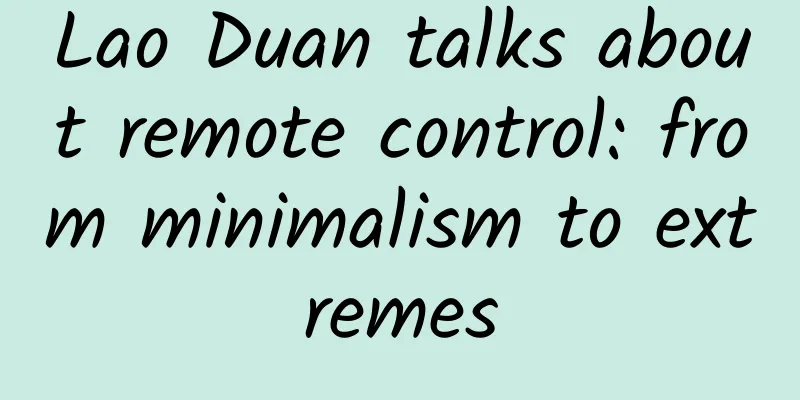Lao Duan talks about remote control: from minimalism to extremes

|
Remote control interaction has become the focus of Internet-based TV and Internet TV. In fact, I do not agree with making the TV remote control "minimalist". My view is that "the more buttons on the remote control, the better, provided that it can be basically blind controlled". Commonly used buttons must be able to be blind controlled and easy to operate in a semi-dark environment. But I think some other functional buttons should also be placed on the remote control, such as 3D, voice, settings and so on. Because compared with PCs and mobile screens, the remote control is the real portal and entrance to Internet-based TV, which is the most essential difference from other screens that use a mouse or touch operation. But set-top boxes are different from TVs because the functions and settings that need to be controlled on set-top boxes are far less than those on TVs. Therefore, the remote control of set-top boxes can be "extremely simplified", which is why 11-button remote controls are popular on set-top boxes (if you only watch videos and don't consider game applications, you can further simplify it to 9 buttons). Here, we carefully compare the 11-button remote controls of Xiaomi Box and Ultra HD Box, trying to find some clues from minimalism to extremes in remote control design. How much does an 11-button remote control cost? First of all, you should know that the cost of this 11-button remote control is less than 10 yuan or more than 10 yuan, so we must make an evaluation based on this cost to be meaningful. It is difficult to make an electronic device that only costs 10 yuan very perfect without hard work. Many colleagues and friends who participated in the testing of engineering machines said that the remote control of TCL iQiyi TV is much better, haha, that remote control costs hundreds of yuan! There is basically no comparison between them. How big should an 11-button remote control be? I have joked with many people about the size of the remote control: as long as it doesn't look small when you hold it in your hand and it is obviously narrower than an iPhone, the size of the remote control is appropriate. This is a simple and effective test method. The reason is self-evident, because iPhone is designed for Western hands, and we design the remote control according to the size of Eastern hands. And it should be smaller, because there are relatively more female TV users. From the first generation of Xiaomi to the second generation of Xiaomi, the remote control has obviously "grown up". Of course, one reason is that it has to adapt to the size of the TV. It is a bit inconsistent if it is too small. The size of the ultra-clear box remote control is between the two. Visually, it matches the box better. In terms of use, the size of the Xiaomi is better. The width and thickness of the two differ by 2 mm, and the length differs by a little more than 1 cm. The “three senses” of the remote control? 1. Look and feel: Xiaomi's is more square, and the volume button is up and down (this is particularly interesting. The buttons on the Xiaomi remote control are up and down, which is very intuitive, but the volume adjustment bar is actually a circle. I have to ask why when I have a chance?). The HD box remote control is more rounded, and the buttons are neatly arranged in a somewhat rigid functional manner. The Xiaomi remote control is larger in size, but the buttons are smaller, so it feels more "white" and more artistic visually. The HD box takes a more simple and practical route. I have asked many people and made many comparisons. Basically, everyone has their own preferences. I personally like freehand Chinese paintings and don't like the rounded rectangles of Steve Jobs, so I prefer the appearance design of the Xiaomi remote control. Xiaomi's look and feel wins. 2. Grip: The HD box has a better grip. The reason is simple. The HD box's remote control not only sacrifices the above-mentioned visual effects, but also has chamfers on the four sides of the front, so it feels very comfortable to hold. The four corners are rounded, which is more friendly and less uncomfortable than the Xiaomi remote control with better visual effects. However, because the Xiaomi remote control is long, although the lower right corner is a right angle, it does not hurt the hand. However, the front edge has a noticeable scratchy feel, which is uncomfortable. Although the two remote controls are different in size, the weight difference is not too large and does not affect the difference in grip. The weight that is more acceptable to users, especially women, is 45 to 65 grams, which is not too different. 3. Key feel: This is the most critical user experience among the three senses. First of all, we have to talk about the user's comfortable control area, as shown in the figure. 9 of the 11 keys of the HD box remote control can be blindly controlled, and most people have to change the position of their hands when adjusting the volume. What is more interesting is that the Xiaomi remote control also has 9 keys that can be blindly controlled, and you need to change the position of your hands when pressing the standby key and reducing the volume. The conclusion of this comparison is half a catty and eight halfs. The second is the key. After the Xiaomi size is larger, the key is made smaller, with a diameter of less than 8 mm, while the key of the HD box remote control is 9 mm, but because Xiaomi has made a high protrusion on the return key, it does not affect the blind control. Because the three keys are to be arranged in a row, the keys must be made smaller, otherwise the distance cannot be separated. The remote control of the HD box is relatively small by 2 mm, and only two keys are placed horizontally, and the home key is placed on top. But in this way, the three keys of the home page, return, and menu are all around the positioning area of the direction key, so they can be pressed directly, while Xiaomi needs to find the return key first and then locate the menu key and home key, which requires two positionings. Xiaomi wins in terms of blind control clarity, but the HD box wins in terms of ease of use. In terms of key feel, the HD box wins because of the large keycaps. In addition, the most important positioning point, the OK key, is obviously superior to the HD box in terms of arc. It fits the thumb very well when pressed. Xiaomi's arc is small and a bit stiff. Moreover, after the size of the remote control is larger, the OK key is smaller than that of the HD box. The design of the Xiaomi box OK key is not careful enough. In addition, the arc of Xiaomi's direction keys is very large, which feels better than that of the HD box, but the HD box is designed with convex points, and the blind control feels clearer. However, the visual effect is not as good as Xiaomi's blank design because of the four small dots. In terms of key strength and feel, Xiaomi 2 is not as good as Xiaomi 1. I think it may be because of the change of OEM factory. The keys are too hard, the tolerance gap is too large, and the keys shake a bit, which does not meet the quality standards of Xiaomi box. The first batch of HD box engineering machines also had similar problems, but the quality of the later batch of official products has been greatly improved. They are tightly fitted and there is no shaking when touched lightly, which gives people a more refined feeling. There are two schools of thought on the key strength: one school likes strong feedback, long key travel, strong force, and even sound feedback. The other school is light force, of course it must be clear, and the key sound must be soft, so that it is not tiring to press continuously, it is comfortable, and it looks high-end and exquisite. These are the two schools of thought. I tend to the latter. After research, I think the force of 110-130 grams (the error of accessories of different quality is large) is the best force range. However, Xiaomi's design is also understandable, but the tolerance seam quality and the gap between the direction key and the OK key need to be improved in the second generation of Xiaomi remote control, and it feels backward compared to the first generation. In addition, many TV remote controls are made of relatively soft rubber, which actually feels great, but does not look exquisite and high-end. If some good process treatment is done, rubber can also be made into a high-end remote control. There are also remote controls that are larger in size and suitable for hand shape, which have poor visual effects, but feel good to use. Finally, I would like to say one more thing. Many people think that it is not difficult to improve the process accuracy of the tolerance seam of the remote control. In fact, it is not easy. Because the current factories are all serial assembly line mechanisms, the final process accuracy is determined by the worst link of the assembly line. For example, if you want to make the key seam smaller, you will inevitably encounter the problem of key jamming. Therefore, experienced MDs must leave margins for these links. Otherwise, serious quality problems will occur in order to improve a little bit of seemingly unimportant accuracy, which is an accident. How to make a remote control with the ultimate overall quality? In addition to the above comparisons and discussions, the most critical thing is of course "quality". Making the quality of the remote control good is a basic requirement, which is not within the scope of "extreme" that we are focusing on today. How to make a minimalist remote control extreme, there are also the following questions: 1. Sensitivity: The sensitivity of the remote control includes two time intervals: one is when the interface starts to react after pressing a key, and the other is when the action is completed. The latter is the time of the set-top box system and has nothing to do with the remote control. The former includes the processing of the remote control, infrared signal transmission, reception and interface reaction. The key is software and interference. Xiaomi Box and Ultra HD Box do very well in this regard. 2. Interface matching: This is an issue that is easily overlooked. I often say that many remote control interaction problems are not caused by the remote control, but by the interface. The size, distance, breathing, and other effects of the interface focus, such as magnification, color change, yin and yang. In this regard, Xiaomi Box and Ultra HD Box are both METRO's XBOX style. I have always believed that this design is the only design in Internet UI that comes from life, and it is most suitable for TV, more suitable for TV than mobile phones and PADs. 3. The degree of wear and tear. The silk screen will fade after a long time of use. In fact, it does not affect the use too much, because after a period of use, you don't need to see the silk screen on the key, but it affects the appearance. 4. The remote control should have a power light. This is not expensive and is very useful. But it is a pity that the first and second generations of Xiaomi Mi Box do not have this design. 5. Fatigue test. This mainly tests the metal dome, and it is a quality issue where you get what you pay for. 6. Battery compartment design. Xiaomi is better, of course this is related to the large size of Xiaomi remote control, the push-pull design is easy to understand and use. The ultra-clear box is small in size, and neither the first generation of Xiaomi remote control uses a push-pull design. One is a circular rotation and the other is a buckle. They are not as good as the push-pull design, but the look and feel is better . Material and surface treatment. Both remote controls have a matte design on the front, and the surface particles should be similar, at least the visual difference is not noticeable. However, the HD box on the back has a glossy design, which looks high-end, but it obviously collects fingerprints. Xiaomi uses the same matte design as the front, which should be more practical. Because of the low cost, neither remote control uses more high-end materials and designs similar to mobile phone shells. I have always believed that it is worth spending a little more money on the appearance of the remote control, because this thing is in the hands of the user, so it is actually closer to the user than the set-top box and the TV, and it needs a higher quality user experience. However, most traditional manufacturers are reluctant to spend more money on the remote control. The reason is that the remote control is an independent device, which is particularly easy to quantify and compare costs. However, manufacturers are usually willing to spend a lot of money on the design of the remote control, because the cost of design personnel and consumables is implicit, but the cost of external procurement is very explicit, the unit price multiplied by the quantity, so if one extra dollar is spent on external procurement of the remote control, the procurement, finance, and bosses of the TV manufacturer will feel very distressed. In addition, traditional manufacturers have no motivation to put a lot of thought into remote controls, because in the era of selling points, everyone is still competing for gimmicks that are easy to promote and impress users when they buy, but it is difficult to create these gimmicks on remote controls. This is the most critical obstacle to whether remote controls can achieve perfection. As a winner of Toutiao's Qingyun Plan and Baijiahao's Bai+ Plan, the 2019 Baidu Digital Author of the Year, the Baijiahao's Most Popular Author in the Technology Field, the 2019 Sogou Technology and Culture Author, and the 2021 Baijiahao Quarterly Influential Creator, he has won many awards, including the 2013 Sohu Best Industry Media Person, the 2015 China New Media Entrepreneurship Competition Beijing Third Place, the 2015 Guangmang Experience Award, the 2015 China New Media Entrepreneurship Competition Finals Third Place, and the 2018 Baidu Dynamic Annual Powerful Celebrity. |
<<: Lao Duan talks about OTT: The lost decade of cable TV
>>: Lao Duan said: Intranet OTT is just a dream
Recommend
Xiaomi: A department store disguised as a phone manufacturer
This Tuesday, Xiaomi released a number of new pro...
A guide to avoiding pitfalls when promoting with overseas influencers in 2022!
What are the pitfalls of overseas influencer mark...
"Trimming horse hooves, washing carpets, squeezing blackheads..." Why can't you stop watching these videos?
Produced by: Science Popularization China Author:...
The largest Apple delisting incident in 2018: more than 40,000 apps were removed from the Chinese region in a single day!
Today (June 27), the App Store showed a large-sca...
Fanstong No. 1: Become a Fanstong master in 3 minutes
Hello everyone, I rarely post content on the offi...
Get new skills! Tutorial on how to unlock the Chinese version of PS4
The PS4 game console was officially launched in C...
Pigs are omnivores, do they eat everything?
Pigs have been regarded as honest and cute animal...
Here is a new discovery!!!
On September 7, the reporter learned from the Xis...
Yuanping SEO Training: How to understand the relationship between SEO optimization and website optimization? Which one is more important?
Many friends don’t know the relationship between ...
China Automobile Dealers Association: Analysis of China's imported automobile market in September 2022
Customs import volume (I) Supply: After three yea...
Because of it again! A girl was admitted to the ICU with a skull fracture. Don’t use this “deadly internet celebrity jewelry” anymore
For girls with long hair, the most indispensable ...
Pitfalls you may encounter when using Android notifications
I've recently encountered some issues with An...
Product Operation: How to use data to create a good MVP?
The implementation of MVP is inseparable from dat...
Shanxi, China's real devil dialect area
Shanxi, as a provincial administrative unit, is a...









